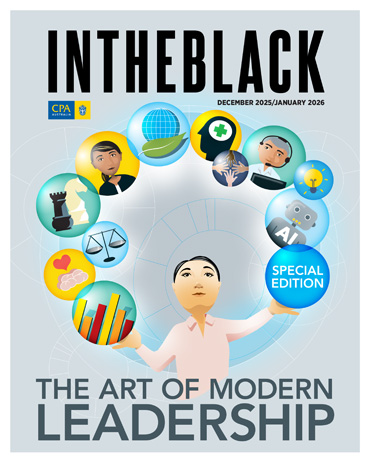Loading component...
At a glance
Investment in new technology holds huge promise for accountants, but deciding what to buy, when to buy it and who to buy it from can be a challenge. Looking past the spin that surrounds technology like artificial intelligence (AI) also requires asking tech providers some important questions.
The results of CPA Australia’s Business Technology Report 2024 show businesses that utilise technologies are significantly more likely to report a profit increase than businesses that do not.
For example, 94 per cent of companies that use digital payment technologies experienced a boost in profit in the preceding 12 months, while only 5 per cent that did not adopt the technology reported similar gains.
However, not all tech innovations deliver meaningful value, and what works for one accounting practice or finance department may not deliver noticeable value for another. Here’s how to sort through the offers.
Separating tech hype from reality
Professor Michael Davern FCPA, chair of accounting and business information systems at The University of Melbourne and a member of CPA Australia’s Digital Transformation Centre of Excellence, says successful technology investment begins with a thorough understanding of business requirements.
“Too often, a technology push is not driven by a business need,” he says. “The investment should be business-led, not technology-led.”
Innovation and digital strategist, Scott Bales, says rather than focusing on what smart tech can do, accountants should base investment decisions on why the tech was created.
“By reframing technology to consider why it exists, as opposed to just what it is, you’ll have a better investigative approach to its strategic potential for your organisation or your industry,” says Bales, a keynote speaker at CPA Congress 2025 in Kuala Lumpur.

Kyelie Baxter FCPA, managing director of IQ Accountants, says there is a risk of buying technology based on trends rather than the problems it can solve.
“For me, the real focus is on tech that delivers today — automation, AI, analytics — because this is what frees up the team and gives us faster and better insights,” she says.
“Technology like blockchain may not be something that impacts your practice on a day-to-day level, unless you’re operating in niche areas like digital assets or supply chain auditing for example, so focus on what your business needs.”
Pinpointing the required tech
When the problems that technology can help solve have been identified, the next step is choosing what to buy.

Peter Worn, joint managing director at finance technology specialist Finura Group, advises taking a measured approach to new tech investment.
“The guidance we give to firms is that most of the core accounting technologies they use today will no doubt have some AI features in the not-too-distant future, or they already have them, but you just don’t know it,” he says.
“We strongly advise firms that it is okay to wait before getting too deep into an emerging bit of technology, which could be quite disruptive to deploy.”
Baxter says there are common pitfalls in finance tech adoption.
“A tool that operates in a silo and can’t connect with core systems generally creates more work, not less,” she says. “Can it demonstrate a return on investment in a practical way, such as hours saved or tasks removed?
“Also, what training and support is included as well as implementation, and where is the support located? If a support centre only operates when you’re asleep, it is probably not that useful.”
Choose technology that can grow with the business, Baxter recommends, “otherwise, you’ll risk having repeated changeovers, extra costs and, at the end of the day, lost productivity and efficiency. That is not good for you or your clients”.
Bales suggests considering the value technology can create for the business.
“In the finance sector, for example, you evaluate a number of risk scenarios prior to making a decision,” he says.
“The gold standard in 2010 was to do 10 scenarios. Today, you can do a hundred million scenarios, which you could never do before because of a limitation of resources.
“So, we should be thinking about, and challenging ourselves to ask, ‘If we have no limitation on resources, how do we ask bigger, more complex, more value-creating questions within our work that we could never ask before?’.”
What to look for in a tech vendor
Sorting the substance from the marketing spin requires a frank conversation with tech providers.
“Can they show their knowledge of best-practice or cutting-edge use cases for your particular industry or role?” asks Bales.
“Do they have any other customers doing things in a more innovative way than you? What you’re typically looking for is part inspiration and part education in terms of the potential of their technology for your company, role or business unit.”
Worn recommends asking questions about the company that makes the tech.
“It is a good sign if at least some of the founding team have a background in accounting, because it is important to have some professional affinity, experience and understanding of the industry, or even just an awareness of the ethics and governance requirements,” he says.
Davern suggests asking to speak to other customers about their experience with the technology.
“Don’t be the guinea pig unless you have a thorough understanding of the technology and the benefits it will bring to your business,” he says.
After you have made your tech investment, Baxter says training is a vital ingredient for its success. Providing training, managing resistance to change and explaining why the tools matter are essential. After all, “tech fails if the team doesn’t adopt it”.
Four quick tips
- Technology investments in accounting should be driven by clear business needs, not by trends or hype.
- Businesses using digital tools like AI and automation are significantly more likely to report profit increases.
- Choosing the right tech requires understanding the problems it solves and ensuring it integrates well with existing systems.
- Successful tech adoption depends on vendor credibility, user training and team buy-in.

